By Scott Smith | Contributing Editor
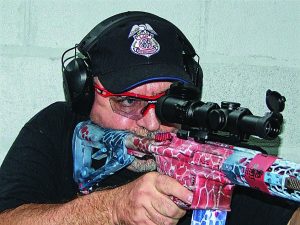
Author shooting his custom Springfield Armory Saint wearing Peltor’s Tactical 500 hearing protection and Rudy Project USA’s Tralyx glasses.
It’s the end of summer; we are experiencing some, if not the hottest, hot days of 2018 and its time to work on The Gun Mag’s annual Christmas issue. It is hard to feel Christmassy when you sweat just sitting on the shady back porch. However, being a consummate professional I have my cold sweet tea next to me to motivate me.
This year I wanted to look at a few items shooters always need or can put to use. We will look at new hearing protection from Peltor, new eye protection from Rudy Project, footwear from 5.11 Tactical, pants/shorts from Dickies and quality affordable optics from Sightmark.
Protecting one’s eyes and ears is of paramount concern to shooter, especially as we age and are experiencing these senses diminish naturally. It is even more important to those who have served in the military and law enforcement and have been subjected to loud noises and dangerously bright light without time to prepare for it. Thank goodness now the military issues eye and ear protection for daily wear!
It is rare to see shooters without proper eye and ear protection, but hunters rarely wear either in the field. They like to use the excuse: “Well, it’s only one shot” or “I will not be able to hear/see my game.” However, loud concussive explosions while possibly only a one-time event can do damage to the optic and auditory nerves. With modern electronic hearing protection not only will sounds be muffled, but your hearing is also enhanced. Quality eye protection will protect your eyes and you can have your optic prescription put into an insert or ground into the shield to give you better vision.
Peltor (Phone: 800-494-3552; Online: 3.com), a division of 3M, is one of the industry leaders in hearing protection. I was first introduced to Peltor when doing flight line security as a security policeman in the USAF Reserve. Peltor supplied the earmuffs we wore during flight line operations; if you did not wear them, you could not hear for hours afterwards. We also wore them during flight operations as Peltor made some of the first muffs for hearing protection and communications.
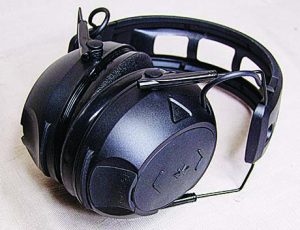
Peltor’s Tactical 500 electronic hearing protection. You can see the on/off button on the side of the cup while the volume and Bluetooth controls are on the end of the cup for easy access. Note recessed wind protected microphones.
Today hearing protection has been drastically reduced in size and weight with increased effectiveness thanks to microcircuits and compression circuits which automatically reduce the decibel level when they encounter dangerous noise levels. Peltor’s Tactical 500 is the latest offering for shooters and hunters.
The Tactical 500 is an electronic unit with Bluetooth capability so you can sync with your mobile devices to listen to your music list. This unit does not have VOX capability, so if you answer your phone whoever is on the other end will know you are on the range. What it does have is 26dB reduction when shooting and, thanks to 3M SMART Technology’s crystal clear voice reception, when you are not shooting.
Peltor has done something I have not seen on other electronic hearing protection; they recess the microphones approximately a sixteenth of an inch from the surface of the muffs. When combined with the built-in wind screen there is a huge reduction in wind noise. Truth be told, with the exception of being caught on the range before a couple of major storms, l did not notice that annoying rustling sound the wind causes. Note to hunters: this is one less excuse for you not to wear these while hunting. I also found this slight recess made range commands clearer when shooting USPSA matches.
Peltor designed the Tactical 500 for ease of operation as well. The one cup has all the controls at your fingertips. The on/off button is opposite of the microphone on the one cup and tells you when it is on or off. Volume buttons are the cap of this cup and the Bluetooth button is in the middle of the volume buttons. All of the buttons have raised symbols, making it easy to feel and operate them.
Batteries are in the opposite cup of the controls. The Tactical 500s operate on AA batteries, ensuring you can find replacements virtually anywhere should a pair die. After one shooting season my original pair is still going strong.
Peltor has also used new polymers in the cup cushions and headband to make the Tactical 500 more comfortable for all day wear. The headband has a soft touch material directly molded over the bands for comfort when worn with or without a hat. The cups’ material is also new and does not get brittle in the cold. I stuck our sample set in the freezer to test the feel; while cold they still molded over my glasses and quickly softened from body heat.
You will find Peltor’s Tactical 500 priced under $120 online. With all of its features, the Tactical 500 is worth every penny. With all the advancements in sound clarity there is no reason for shooters and hunters alike not to wear electronic hearing protection.
Since we were discussing hearing protection, let’s look at a small item to improve your favorite brand. If you are like me you shoot in all kinds of weather and find the cups on many brands get stiff in the cold and unbearably hot in the summer. They also leave a gap where your eye protection goes under them, compromising the noise reduction.
This past year I came across a piece of kit to improve your hearing protection, Noisefighters (Phone: 616-226-3551; Online: noisefighters.com), replacement hearing cup pads. Unlike OEM cups these are gel filled and use a much softer outer material. They also have a ridge that rides under your eye protection, doing away with the gap created by the glasses’ arm.
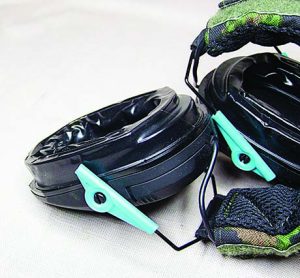
Noisefighters gel pad cup pads fit most popular hearing protection. The ledge allows your shooting glasses to ride above the cup so they do not leave an opening to compromise noise reduction of your ear protection.
I put a pair on my Walker Razors and Howard Leight Impact Bolts. Noisefighters markedly improved the comfort level of both pairs of muffs to the point I did not have a headache after shooting a half-day or all-day major USPSA match. If you shoot a lot, you will appreciate that; I cannot count how many headaches I have had from my shooting glasses being “squished” against the side of my head.
I also noticed range commands and conversations were easier to hear. With the small gap created by shooting glasses being reduced or eliminated the electronic muffs gave better background noise reduction and clarity. This is important from a safety standpoint to hear range commands and just being able to hear what’s going on around you.
A pair of Noisefighters will set you back about $45 delivered to your door. Not only will you be helping to reduce your hearing loss and end those nasty range headaches, but you will be supporting a disabled veteran-owned and operated business. This is a gift idea that helps shooters, our vets and is made in the USA.
Sight Protection
Just like your hearing, you only get one set of eyes and they too need to be protected at all times. For nearly two decades I have been protecting my eyes with Rudy Project (Phone: 949-272-2440; Online; rudyprojectna.com) sunglasses. I chose them because they are one of the few companies to offer the end user the choice of an optical insert or to have Rudy Project grind your prescription into their lenses. I also chose Rudy Project because you can change out the lens color to meet lighting conditions plus their lifetime replacement warranty.
Rudy’s Tralyx has become one of their more popular glasses for shooters. It has been on the market for about two years now and has become the go glasses because of the size offerings; standard, slim and XL giving you the best fit for your face size. Like shoes, one size does not fit all shooters. With more children and women getting into shooting they need shooting glasses to protect them too. Rudy Project further increased the demand for the Tralyx by introducing an optical Rx insert in early 2018.
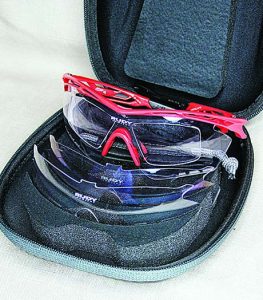
This is Rudy Project’s newest Tralyx shooter’s kit with a clear lens, ImpactX-2 Photochromic Clear to Black, ImpactX Photochromic Racing Red and protective case. I have XL frames; black is standard with your choice of XL or standard lenses.
Rudy Project offers the Tralyx in a shooter’s kit. In the kit you receive the standard or XL frame, a clear lens, an ImpactX-2 Photochromic Clear to Black, ImpactX Photochromic Racing Red and protective case. ImpactX-2 lenses are virtually unbreakable and the case too is virtually indestructible (I know this because I ran mine over with the truck and all the contents survived unscathed). The kit will set you back $399.99. You need to contact Rudy Project for pricing on just the Rx dock which is $79.99. If you have Rudy Project make them, it is $169.99. To have the actual lens ground to your prescription you will have to contact Rudy Project. Price is determined by the lens and your prescription. Personally I like the insert; it gives you an added degree of protection from high velocity debris.
Rudy Project chose these three lenses because they will serve shooters in most lighting conditions. I have found the clear to black works well in summer sun while the clear to Racing Red works well for cloudy days or fall and spring days when light is flatter, with the clear ideal on gray winter days or indoors. You can find other color/light transmission lenses on Rudy’s website if you need more. Over this past summer I used all three lenses. The Photochromic Racing Red and black worked perfectly no matter the lighting conditions.
One feature I have found with Rudy Project glasses is they do not fog up. On large lenses like the Tralyx XL there are small vents in the lens that allow for air flow. It may not seem that these slits would defeat fogging but they do. Anyone who has shot in Georgia in July will appreciate not having your lenses steam up. Be warmed if you hop out of your vehicle with the AC set to Arctic; they will get fogged up from the surface condensation. You cannot stop that.
I wore the Tralyx XL all over the country this year shooting three gun, USPSA and IDPA. I liked the XL because the lens completely covers the ocular orbit from cheek to eyebrow. I found in windy conditions they kept dust out of my eyes and the added wrap would protect my eyes from ricocheting debris. Having had a piece of jacket imbed itself in another pair of shooting glasses, I learned complete protection is best.
How well do Rudy Project glasses wear? Are they worth it? I have been wearing my Rydon’s for 15 years; all I have replaced is one set of temples/nose pieces for $20. I still have all the original lenses and they are used daily. I have not had a scratch even on those that got ran over in the hard case. My eyes are worth the $399.99 cost of the Tralyx. You have to decide; is that too much to protect your eyes?
Often overlooked when we look at protective gear is our footwear. Over the years during matches I have heard more “oh my aching back,” “my legs are killing me,” etc. Nine times out of ten the complainant has on running shoes, football turf shoes or whatever the coolest trail running shoe is. Generally they are also well past their mid-twenties and like me have been hard on their body. The problem is most of the cool kids’ shoes are designed for the guy who has a true athletic build, in pretty good shape and only wears these shoes for running or working out; not for eight plus hours shooting a three gun, USPSA, IDPA or any other shooting competitions.
The problem with the shoes all the cool kids wear is they do not support your feet and ankles when running on uneven terrain. Running shoes are designed to give your foot support from front to back and minimal lateral rotational support. Hence sore back, ankles, feet, and your legs have that tired heavy feeling.
The solution is footwear designed for those who demand the comfort and feel of an athletic shoe and support of a boot like our soldiers, EMTs, LEOs. Gone are the heavy nearly useless “recruit boots” many of us knew in our youth. Today our first responders demand all day comfort out of boots. Over the past couple of years 5.11 Tactical (Phone: 866-451-1726; Online: 511tactical.com) has been working to build boots to answer those needs. The XPRT 3.0 Waterproof is one 5.11’s offerings.
You can purchase the XPRT in publishable black or rough out coyote to meet your professional or personal needs. I opted for coyote because range dust will not show on them. Both colors are waterproof (eVent Protect BBP waterproof lining) and are six inches tall to give you ankle support. The shorter height is also cooler in the summer.
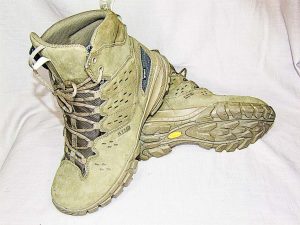
5.11 Tactical’s XPRT 3.0 is an ideal boot for shooters, hunters and outdoorsmen to keep your feet dry; they will keep your feet dry and comfortable all day long.
To ensure you have good traction on all surfaces and in all conditions 5.11 uses a Vibram Ananasi Megagrip outsole. I put the XPRT through its paces in the wet conditions of Rockcastle’s Pro/AM Three Gun. We were shooting on wet wooden bridges, with that god awful wet red southern clay, wet pine needles and perfect bone dry trails. With the exception of slippery moss on a wet wooden bridge that only metal studs would have gripped, I didn’t slip at all. The “self-cleaning” treads did not clog or retain mud, which is why they did not slip in the mud.
The polyurethane midsole and Ortholite Imperial liner are what give you all day comfort. These materials mitigate impact and help give a rebounding affect, a bit like a bouncing ball. 5.11 also uses a slip last which makes the XPRT more flexible. The lacing system uses nylon loops instead of eyelets; this allows the lace to cinch the boot up evenly to give you better support.
Having put 5.11 Tactical’s XPRT 3.0 through its paces in nasty and perfect conditions, I give the boot two thumbs up. My feet stayed dry, they did not ache and I did not lose my footing in the south’s version of ice: wet red clay. With an MSRP of $209.99, they are a few dollars more than cool colored shoes. Not having sore, achy, tired legs and feet makes them worth every penny.
Another piece of kit that makes a day on the range or in the field better is a quality pair of pants/shorts. This past summer I have been wearing Dickies (Phone: 800- 342-5437; Online: dickies.com) Tactical 10” Relaxed Fit Stretch Cargo Shorts that retail for $34.99. For cold weather or uniform wear the Cargo Pants have an MSRP of $49.99.
Dickies uses Ripstop, 43% Elasterell-P w/ Sorona/34% Cotton/23% Poly which ensures the shorts/pants are lightweight, comfortable, dry quickly and look good. The material also has Dupont’s Teflon clothing finish to help repel liquids which reduces stains.
For added comfort the waistband is expandable and the seat is full cut. This means the crotch will not bind and ride up pinching delicate body parts when you are kneeling, squatting, etc.
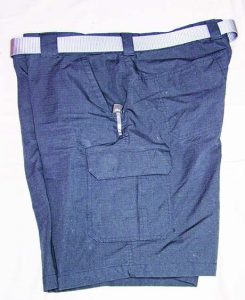
Dickie’s Tactical 10” Relaxed Fit Stretch Cargo Shorts that we wore a lot this past summer. The pants version will be ideal for fall or spring wear.
You will find magazine inserts in the cargo pockets that also will hold a number of smart phones. The rear slash pockets have cell phone pockets in them as well. Dickies knows folks carry clip-it knives and uses an “L-cut” to keep your knife lying flat.
An area often overlooked by clothing manufactures is the belt loop. They are either too small, placed in the wrong place to carry a holster or both. Dickies addressed this issue with 1¾-inch loops with the side loops being centered at the apex of the hip. This means you can wear a belt designed to carry a pistol and your pancake holster will be located properly on your strong side. With two loops in the back instead of a single loop, you will not have a plumbers crack when you bend down.
Overall I think Dickies did a good job designing their Tactical Relaxed Fit Stretch Cargo Shorts and Pants. They fit well, have worn great and have survived coffee and Coke Zero spills. If you are looking to get someone on your shopping list new pants for the range, field, and duty or wearing about town, consider Dickies Tactical Relaxed Fit Stretch Cargo Shorts and Pants.
The last item on our Christmas list is Sightmark’s (Phone: 817-225-0310; Online: Sightmark.com) Citadel CR1 1-6X24 Riflescope. When we were having morning coffee at the Rockcastle Pro/Am as always, we discussed gear. I relayed that I was testing Sightmarks’s CR1 1-6X24 Riflescope and 30mm Cantilever Mount. A few of the guys chimed in they had been shooting CR1s for a couple of years and have had no issues with holding zero or fogging. These guys do not always treat gear with kid gloves. It was good to know a scope with a MSRP is $359.99 was surviving the rigors of three gun and precision rifle competition.
The CR1 is a second focal plane optic; the reticle does not change size as you zoom with a BDC for 55-grain .223 Rem. The center circle dot has variable intensity. I found the circle dot can be seen on all but the brightest of days; this is true for most scopes with this feature. You can adjust the focus of the reticle by turning the ocular lens.
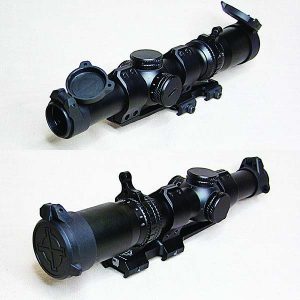
Sightmark’s CR1 variable power optic. This quality piece of glass is ideal for three gun, duty or hunting applications.
Windage and elevations adjustments are very positive; you can feel each click when making adjustments. This scope gives you 120 MOA of adjustment. I had no issues with the CR1/Sightmark 30mm Cantilver combination holding zero and I removed it several times while testing. As always when you remove your optic it is still best to verify zero. While doing my testing on the CR1 I found it to be rated for the recoil of a 50BMG which would explain why my buds have had zero issues with the scope.
I was surprised to see flip-up lens caps and a throw lever included with the CR1. It can be a hassle trying to find flip-up caps for these mid-range scopes. Throw levers make it easy to zoom the lens and it’s almost mandatory for competition shooters. You want as much field of vision as possible on close targets and highest magnification for 300-yard steel when shooting three gun. A hunter also can appreciate a throw lever for the same reason; you may need to make a snap or precision shot on game. The lever allows you to quickly change the magnification.
While finishing this piece, I realized I didn’t have the MSRP of the mount so I did a quick search online and found the MSRP is $73.99. A bit further research showed it could be had for under $64 and the CR1 could be had for under $300. In this day and age a well-made optic and mount for under $400 is a good deal. After the input from my buds and my work with Sightmark’s CR1, I say it’s a deal that will make an excellent gift for the holidays.
Hopefully this will help you with some ideas for gifts for shooters, hunters, armed professionals and outdoorsman on your gift list. I want to wish you all a safe and Happy Hanukah and Merry Christmas as well as a Happy New Year. I know many of you will head out to the woods or range during the holidays; please be safe, shoot straight and have fun.



